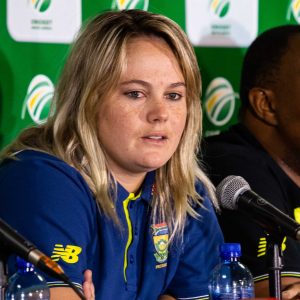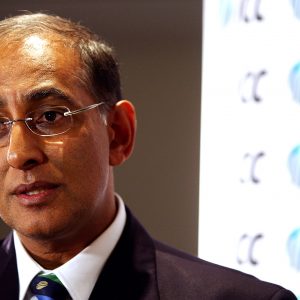Laura Wolvaardt driving her way to stardom
SA’s reigning Cricketer of the Year is back in Australia where she played a memorable shot. She talks about her Proteas role and the impact Covid-19 has had on women’s cricket.
Author:
24 October 2020

Laura Wolvaardt stands in the middle of the Sydney Cricket Ground. She taps her bat once on the hard pitch with an authoritative thump, steadying herself.
South Africa’s 21-year-old middle-order batter has both her knees bent. Her weight is leaning forward. Her head is still. Her gloved hands are down by her waist, like a gunslinger waiting for the town clock to give her permission to open fire.
Nicola Carey is gathering pace as she runs toward the middle. She has a white Kookaburra ball in her hand and her team’s momentum behind her. Australia’s 31-year-old all-rounder knows that this 2020 ICC Women’s T20 World Cup semifinal is as good as won. All she has to do is keep Wolvaardt quiet.
Rain has affected South Africa’s run chase. Meg Lanning, Australia’s captain and one of the greatest players of all time, knocked off a run-a-ball 49 to drag her team to 134 from 20 overs. But the gods love their tricks and South Africa have just 13 overs to get 98 against the pre-tournament favourites.
Three balls into the 10th over, Carey leaps and gathers in her delivery stride. Wolvaardt’s head is no longer still. Along with her body, it’s moving rapidly towards the leg side and away from her stumps, exposing them, leaving them at the mercy of the ball. Carey does the right thing and ignores the bait. Instead she follows Wolvaardt, sending down a space-cramping delivery that should force the woman with the willow to hit it towards a more defended part of the field.
Wolvaardt has other intentions. Her body is in motion but her target is fixed. The ball bounces in the slot – the Goldilocks zone all batters love to hit from – but her balance is paramount. If she falls too far in the direction she is moving, she has no chance of a clean connection.
Related article:
As if held in place by an invisible harness she keeps her shape. Her front knee remains bent. Her hands move in a fluid motion. Her core is like a pillar of the Parthenon and when her D&P Hydro bat makes contact with the ball, it creates a sound that elicits an audible gasp from all who are watching.
“Is it possible to marry a cricket shot?” the International Cricket Council (ICC) wanted to know on its YouTube channel, replaying the moment from every possible angle.
The ball exploded to the cover boundary, arcing over the infield and skipping past the perimeter. It added four runs to South Africa’s cause. Wolvaardt would hit another two boundaries – a heaved six over midwicket and a scythed four backward of point – but her unbeaten 41 from just 27 balls could not secure victory for her side. Australia won by five runs. Three days later, Lanning lifted her country’s fifth T20 World Cup in front of 86 174 people in Melbourne.
The beauty of the cover drive
“I have watched it a few times,” Wolvaardt says before her return to Australia to represent the Adelaide Strikers in the Big Bash League.
She laughs a little, almost sheepishly. She knows how indulgent it is to revisit past triumphs, especially when she has the ingredients to be one of the most decorated Proteas of all time.
But therein lies the beauty of that stroke. Driving, particularly cover driving, is indulgent. Pull shots are violent, cut shots are aggressive, flicks through the on-side are disdainful but there is poetry in the cover drive. It is the cricket equivalent of Oscar Wilde sipping champagne on a chaise lounge while sweet-talking a lover. It oozes class and decadence. Wolvaardt executes it as well as anyone ever has.
“It’s a beautiful thing when done right,” she says. “It’s always been my get-out-of-jail-free card. I’ve always practised it and thankfully it developed as a strength of mine. Now whenever I walk out to bat, most captains send a sweeper to the cover boundary immediately.”
The joy of the cover drive is rooted in its simplicity. Almost anyone can play it. It’s perhaps the easiest cricket scoring shot to execute (the agricultural mow over cow-corner excluded). But not everyone can do it well. Not everyone can make grown men purr like kittens with its unfurling.
Related article:
Wolvaardt is a rare breed of batter. She does not force the ball to go anywhere it didn’t already intend on going. All she does is invite it there with a flash of her blade.
To do this one must possess a sound technique. Wolvaardt has been honing hers from a very young age. When she was just 11 she had her first taste of senior cricket, competing for Western Province in an Under-19 interprovincial tournament.
Facing bowlers able to crank it faster than anything she had seen before meant a cavalier approach would only end in disaster. She needed to line up every ball, move back and across when defending, keep her elbow high and her head still. Soon she was opening the batting, rope-a-doping in the crease like Muhammad Ali in his pomp.
She accelerated through the ranks and made her senior international debut in February 2016 as a 16-year-old, opening against England in a one-day international (ODI) in Benoni. Though she struggled in that first encounter, stuttering to five from 24 balls, her 55 in the next game in Centurion pointed to her potential.
In August that year she made her T20 international debut against Ireland in Dublin. A breezy 24 off 26 contributed to a four-wicket win, but something didn’t quite click in the shorter format.
Remembering the basics of batting
“I’ve struggled with T20s in the past,” Wolvaardt confesses. In her first 10 T20 internationals she scored 195 runs at a modest 21.6. Until the recent World Cup, she had only scored one half-century.
Conversely, her ODI numbers were exceptional from the start. Her first 10 games yielded 318 runs at 35.3 with two fifties and a 105 in Ireland. She ended 2017 as the fifth-highest ODI run scorer that year, amassing 643 runs at an average of 58.45. But her strike-rate of 64.94 was the lowest among the top 20 run-getters and she knew something had to change if she wanted to be successful across formats.
“Power hitting does not come naturally to me,” she explains. “Whenever I’d try to go big I’d lose my shape and would play an ugly shot. I’d watch the replay and I’d be so annoyed with myself. I’d think, ‘That’s not me. That’s not how I play’. I forgot the basic principles of batting.”
Related article:
So she got to work. With Laurie Ward, a respected coach in Cape Town, Wolvaardt added grunt to her guile. Endless hours were spent whacking balls into orbit. She increased the speed of her bat swing and came to realise that strike-rates are not solely built on a high boundary count but also by turning comfortable singles into well scampered twos.
“I’ve always had the shots in me,” she says. “I needed to change my mindset. I would compare myself to other girls. But my game is based on technique and playing the right shots to the right balls. I found a way to be a destructive T20 cricketer by staying true to myself.”
Not that change came quickly. Two seasons with the Brisbane Heat in the Big Bash were unproductive. In 2018 she ended with a disappointing average of 6.4 from six matches and didn’t do much better in 2019 with an average of 9.5 from 11 innings. Though she did take part in the triumphant final against the Sydney Sixers, providing a cameo nine off five at the death.
Those numbers were never going to be enough to retain her contract with the Heat and she spent the summer of 2019-20 watching six of her national teammates compete in the best competition in the world.
Choosing cricket over medicine
Wolvaardt doesn’t need cricket. She matriculated top of her class at Parklands College in Bloubergstrand with seven distinctions and was gladly accepted at Stellenbosch University’s medical school. In an alternate universe she is on her way to becoming a doctor.
“I started studying for two months after school, but soon realised I couldn’t tour with the Proteas,” Wolvaardt says. “The university let me defer for two years but after that I had to make a difficult decision. They must think I’m crazy to turn down a place in med school.”
Now studying a BSC in life sciences with physiology and genetics through long-distance learning at UNISA, Wolvaardt’s primary focus is on her sport. She is part of a second generation of professional women cricketers in South Africa and is one of 14 players with a central contract.
“I know how blessed I am that I get to do this for a living,” she says. “Some of the older girls talk about a time when they had to hold down one or two jobs so they could play cricket. They had to pay for their own flights. Now we fly business class and stay in nice hotels. That’s why we feel an obligation to leave the game in a better place than we found it. I’m grateful to those who came before me.”
Wolvaardt is certainly repaying her debt to the game. Her dazzle with the bat in this year’s World Cup – which included a match-winning 53 not-out against Pakistan – has helped advance the standing of women’s cricket in the country. In a year Cricket South Africa would like to forget, one branch of the withering tree at least is in good health.
Related article:
“Covid came at a bad time for everyone, obviously, but we felt we had really gained momentum after the World Cup,” says Wolvaardt, who was recognised as the best player in the country, along with Quinton de Kock, at CSA’s annual awards ceremony in July. “There is still a gap between the men and women, but we’re closing it.”
That match in Sydney back in March was Wolvaardt’s last since the world ground to a halt. A scheduled tour to England was scrapped at the last minute and an undercooked West Indies took South Africa’s place. That was difficult for Wolvaardt and her teammates though there is no bitterness.
A light is emerging in some parts of the world at least. Cricket in Australia has returned. All 59 matches of the Big Bash will be played across five venues in Sydney where an Olympic-style sports village has been set up. Wolvaardt has fond memories of the city.
In the middle of its famous cricket cathedral, she backed away from her stumps and unleashed a stroke of genius. One shot does not make a cricketer. But it has the power to make a legend.




